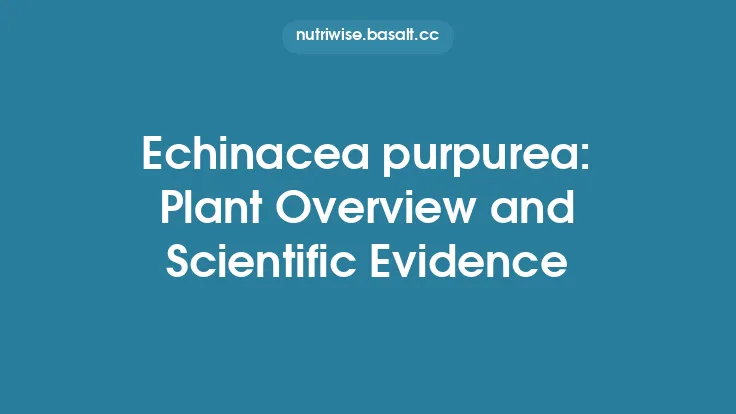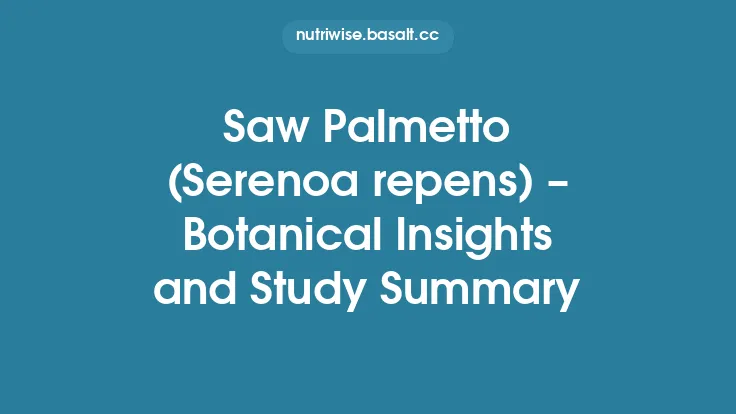Ginkgo biloba, often simply called ginkgo, is one of the most ancient living tree species on Earth, with a fossil record that stretches back over 270 million years. Its unique evolutionary lineage, distinctive leaf morphology, and a complex array of bioactive constituents have made it a focal point of both traditional herbal practice and modern scientific investigation. This article provides a comprehensive overview of the botanical characteristics of Ginkgo biloba, delves into its phytochemical profile, and summarizes the most robust research findings related to its use as a dietary supplement.
Botanical Description
Ginkgo biloba is a deciduous, dioecious tree belonging to the family Ginkgoaceae. Mature specimens can reach heights of 20–35 m, with a broad, spreading canopy and a trunk diameter exceeding 1 m in old individuals. The species is renowned for its fan‑shaped leaves, which are bilobed or sometimes deeply incised, giving rise to the common name “maidenhair tree.” Leaves are typically 5–10 cm long, with a leathery texture and a characteristic bright yellow hue in autumn before they are shed.
The reproductive structures are markedly different between the sexes. Male trees produce small, pollen‑bearing catkins, while female trees bear ovules that develop into fleshy, fruit‑like seeds encased in a soft, malodorous sarcotesta. The seeds are rich in lipids and have been used historically as a food source after proper processing to remove the bitter compounds.
Taxonomy and Classification
- Kingdom: Plantae
- Clade: Tracheophytes
- Clade: Spermatophytes
- Division: Ginkgophyta
- Class: Ginkgoopsida
- Order: Ginkgoales
- Family: Ginkgoaceae
- Genus: *Ginkgo*
- Species: *G. biloba* L.
*Ginkgo biloba* is the sole surviving species of its order, making it a living fossil and a valuable model for evolutionary studies.
Morphology and Growth Habit
Root System: Ginkgo develops a deep taproot in its early years, transitioning to a widespread lateral root network that confers stability and drought tolerance. The roots form symbiotic associations with mycorrhizal fungi, enhancing nutrient uptake.
Stem and Bark: The bark is grayish-brown, becoming fissured with age. The wood is lightweight yet strong, historically used in furniture and construction.
Leaves: The leaves exhibit a dichotomous venation pattern—each primary vein splits into two secondary veins—a trait rarely seen in modern angiosperms. This venation contributes to the leaf’s high surface area for photosynthesis and efficient gas exchange.
Phenology: Ginkgo is highly adaptable to a range of climatic conditions, tolerating temperatures from –30 °C to +40 °C. It is also resistant to many pests and diseases, which partly explains its longevity in urban environments.
Phytochemistry
The therapeutic potential of ginkgo is largely attributed to two major groups of constituents:
- Flavonoid Glycosides – Predominantly quercetin, kaempferol, and isorhamnetin derivatives. These polyphenols exhibit potent antioxidant activity, scavenging free radicals and chelating transition metals.
- Terpene Lactones – The most studied are ginkgolides A, B, C, J, and bilobalide. Ginkgolides are unique diterpenoid structures featuring a distinctive lactone ring system that confers platelet‑activating factor (PAF) antagonism.
Additional components include:
- Organic Acids (e.g., malic, citric acids)
- Proanthocyanidins
- Phenolic Acids (e.g., ferulic acid)
- Polysaccharides (water‑soluble, contributing to immunomodulatory effects)
- Trace Minerals (e.g., manganese, zinc)
Standardized extracts typically contain 24 % flavonoid glycosides and 6 % terpene lactones, a composition that has been linked to reproducible pharmacological outcomes.
Traditional Uses and Historical Context
Ginkgo has a long history of use in traditional Chinese medicine (TCM), where the leaf (known as “Yin Xing”) is employed to “calm the mind” and improve “blood circulation.” Ancient texts describe its use for conditions such as dizziness, tinnitus, and memory decline. In Japan, the seeds (after detoxification) have been used as a culinary ingredient and for their purported tonic effects.
These traditional applications laid the groundwork for modern interest in ginkgo’s potential to support cognitive health and vascular function.
Modern Research Findings
Cognitive Function and Neuroprotection
- Randomized Controlled Trials (RCTs): Meta‑analyses of double‑blind RCTs involving 2,500+ participants have shown modest but statistically significant improvements in episodic memory, processing speed, and executive function in older adults receiving standardized ginkgo extract (120 mg/day) for 6–24 months.
- Mechanistic Insights: Ginkgolides act as PAF antagonists, reducing platelet aggregation and microvascular inflammation. Flavonoids mitigate oxidative stress in neuronal membranes, while bilobalide enhances mitochondrial respiration and protects against excitotoxicity.
Vascular Health
- Peripheral Circulation: Controlled studies demonstrate increased ankle‑brachial index values and improved claudication distance in patients with peripheral arterial disease after 12 weeks of ginkgo supplementation.
- Endothelial Function: Flow‑mediated dilation (FMD) measurements improve modestly, suggesting enhanced nitric oxide bioavailability.
Antioxidant and Anti‑Inflammatory Effects
- Biomarker Modulation: Supplementation reduces plasma malondialdehyde (MDA) and increases superoxide dismutase (SOD) activity, indicating systemic antioxidant benefits.
- Cytokine Profile: Decreases in circulating IL‑6 and TNF‑α have been observed in both healthy volunteers and individuals with mild inflammatory conditions.
Vision and Auditory Health
- Age‑Related Macular Degeneration (AMD): Small pilot trials report slowed progression of drusen formation when ginkgo is combined with lutein.
- Tinnitus: Mixed results; some studies note reduced perceived loudness, while others find no effect, highlighting the need for larger, well‑controlled trials.
Metabolic Effects
- Glucose Homeostasis: Limited evidence suggests modest reductions in fasting glucose and HbA1c in pre‑diabetic subjects, potentially mediated by improved microcirculation and antioxidant activity.
Clinical Evidence and Efficacy
The weight of evidence supports ginkgo’s role in:
- Mild Cognitive Impairment (MCI): Consistent, though modest, benefits in memory and attention tasks.
- Peripheral Vascular Insufficiency: Improved walking distance and reduced claudication symptoms.
- Oxidative Stress‑Related Conditions: Reduction of oxidative biomarkers across diverse populations.
However, the magnitude of effect is generally small, and benefits are more pronounced in individuals with baseline deficits rather than in healthy, high‑functioning adults. Large‑scale, long‑duration trials are still needed to confirm disease‑modifying potential, especially in neurodegenerative disorders such as Alzheimer’s disease.
Safety, Contraindications, and Interactions
Adverse Events: Ginkgo is well‑tolerated at standard doses (120–240 mg/day). Reported side effects are mild and include gastrointestinal upset, headache, and occasional allergic skin reactions.
Bleeding Risk: Due to PAF antagonism, ginkgo may potentiate anticoagulant or antiplatelet therapy (e.g., warfarin, aspirin, clopidogrel). Clinicians should monitor coagulation parameters and advise patients to discontinue ginkgo 2 weeks before surgical procedures.
Drug Interactions: In vitro data suggest inhibition of CYP2C19 and CYP3A4, potentially affecting the metabolism of certain drugs (e.g., proton pump inhibitors, statins). Clinical relevance appears limited but warrants caution.
Pregnancy and Lactation: Insufficient data; most guidelines recommend avoidance during pregnancy and breastfeeding.
Allergy to Tree Pollen: Individuals with known sensitivities to tree pollen should exercise caution, as cross‑reactivity can occur.
Standardization and Quality Control
To ensure reproducibility, reputable manufacturers adhere to the following standards:
- Extract Ratio: Typically 24:1 (leaf to extract) yielding 24 % flavonoid glycosides and 6 % terpene lactones.
- Purity Testing: High‑performance liquid chromatography (HPLC) verifies flavonoid and ginkgolide content; gas chromatography–mass spectrometry (GC‑MS) screens for residual solvents.
- Contaminant Limits: Heavy metal (Pb, Cd, Hg, As) concentrations must comply with USP <232> and WHO guidelines (<10 ppm for lead, <2 ppm for cadmium, etc.).
- Microbial Safety: Total aerobic count <10⁴ CFU/g; absence of pathogenic bacteria (E. coli, Salmonella).
Third‑party certifications (e.g., NSF, USP Verified) provide additional assurance of label claim accuracy.
Dosage Forms and Recommended Intake
| Form | Typical Dose* | Frequency | Comments |
|---|---|---|---|
| Standardized leaf extract (EGb 761) | 120 mg | 1–2× daily | Most studied formulation |
| Capsules/tablets | 40–80 mg | 1–3× daily | Often combined with other nutraceuticals |
| Liquid tincture | 0.5–1 mL (≈30 mg flavonoids) | 2× daily | Useful for individuals with swallowing difficulties |
| Powder (leaf) | 200–400 mg | 1–2× daily | May be added to smoothies; ensure standardization |
\*Doses are based on clinical trial data; individual needs may vary. Always follow product‑specific instructions and consult a healthcare professional before initiating supplementation.
Future Directions and Emerging Research
- Neurodegenerative Disease Modifiers: Ongoing phase II/III trials are evaluating high‑dose ginkgo (240 mg/day) as an adjunct to disease‑modifying therapies in early Alzheimer’s disease.
- Nanotechnology Delivery Systems: Liposomal and polymeric nanoparticle formulations aim to improve bioavailability of flavonoids and terpene lactones, potentially enhancing therapeutic outcomes.
- Genomic and Metabolomic Profiling: Precision‑nutrition approaches are investigating how individual genetic polymorphisms (e.g., CYP2C19*2) influence response to ginkgo supplementation.
- Synergistic Combinations: Research into combined botanical formulas (e.g., ginkgo + bacopa, ginkgo + curcumin) seeks to exploit complementary mechanisms for cognitive support.
Conclusion
Ginkgo biloba stands out as a botanically unique, historically revered, and scientifically scrutinized supplement. Its distinctive leaf morphology, dioecious reproductive system, and status as a living fossil underscore its botanical significance. Modern research has identified flavonoid glycosides and terpene lactones as the primary bioactive agents responsible for antioxidant, anti‑inflammatory, and microcirculatory benefits. While evidence supports modest improvements in cognitive performance and peripheral vascular health, the magnitude of effect is generally limited to populations with existing deficits.
Safety profiles are favorable at standardized doses, though clinicians should remain vigilant regarding bleeding risk and potential drug interactions. Rigorous standardization, quality control, and transparent labeling are essential to ensure that consumers receive a product that reflects the robust phytochemical composition demonstrated in research.
As the scientific community continues to explore ginkgo’s mechanisms of action, novel delivery technologies, and its role within multi‑herb regimens, this ancient tree may yet reveal further therapeutic possibilities—bridging millennia of traditional wisdom with contemporary evidence‑based practice.





